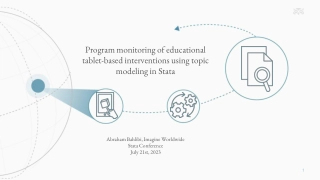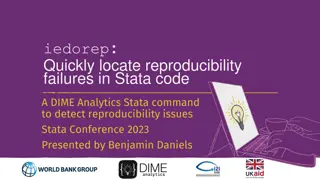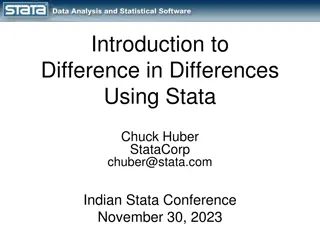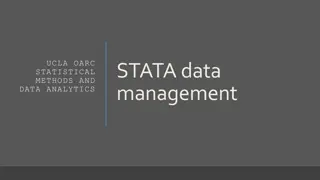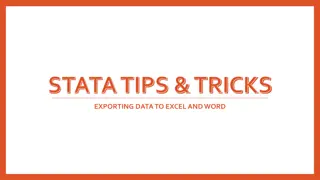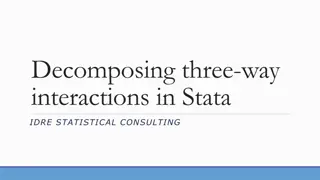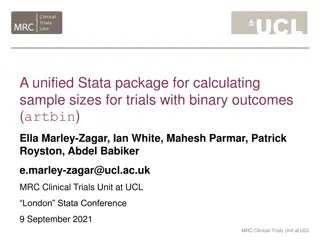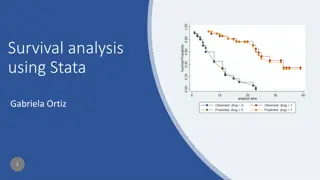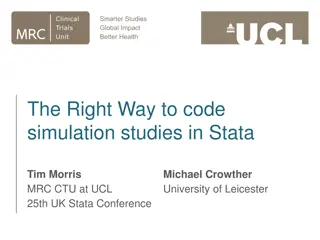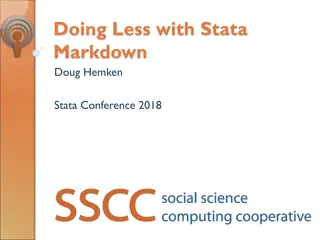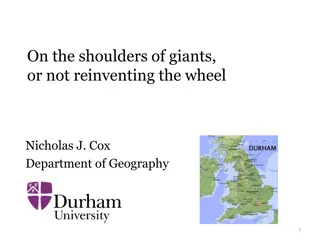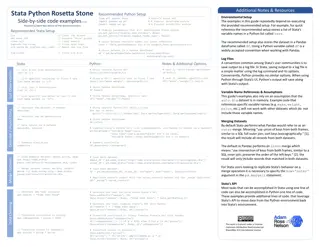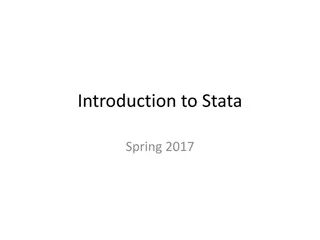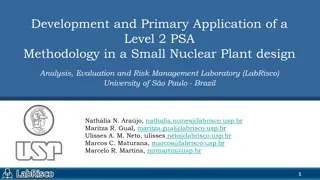Understanding Q-Methodology: A Stata Analysis Overview
Q-Methodology is a research approach focusing on subjective viewpoints. This article discusses the history, goals, and steps involved in a Q-methodology study using Stata programs. It covers the development of a concourse, creation of a Q-sample, Q-sorting activities, and analysis and interpretation. Get insights into how and why people think the way they do in Q-studies.
Download Presentation

Please find below an Image/Link to download the presentation.
The content on the website is provided AS IS for your information and personal use only. It may not be sold, licensed, or shared on other websites without obtaining consent from the author. Download presentation by click this link. If you encounter any issues during the download, it is possible that the publisher has removed the file from their server.
E N D
Presentation Transcript
Using Stata for Q-methodology Studies Noori Akhtar-Danesh, PhD McMaster University Hamilton, Canada E-mail: daneshn@mcmaster.ca
Outline Outline Introduction: what is Q-methodology & how it works? Stata programs for Q-methodology analysis qconvert qfactor qpair 1. 2. 2 2023 Stata Conference, Stanford
Q-methodology (QM): History QM was introduced by William Stephenson in 1935 in a letter to Nature He defined it as the objective study of subjectivity or a person's point of view on any matter of personal or social importance (McKeown and Thomas, 1988) 3 2023 Stata Conference, Stanford
Goals in a Q Goals in a Q- -methodology study methodology study To identify different patterns of thought (not necessarily their numerical distribution among the larger population) The research emphasis is to understand how and why people think the way they do; not how many people think in a certain way 4 2023 Stata Conference, Stanford
Four steps in a Q-study A Q-study involves four steps: 1. Developing the concourse 2. Identifying a sample of representative statements from the concourse (Q-sample) and developing a Q-sort table 3. Q-sorting activities (Data collection) 4. Analysis and interpretation 5 2023 Stata Conference, Stanford
QM: The Concourse Concourse:Includes all statements related to ideas, feelings, concerns, and preferences about the topic of study A concourse can be collected from Interviews, focus groups Commentaries from newspapers Literature review ?????? 6 2023 Stata Conference, Stanford
QM: Q-sample Q-sample (Q-set) is a representative set of statements including all the major viewpoints, feelings, and preferences in the concourse The statements in the Q-sample are numbered randomly Then each statement is typed on a piece of paper (e.g., 3X5 cards) or used online! 7 2023 Stata Conference, Stanford
Example 1: Example 1: Marijuana Legalization (ML) Marijuana Legalization (ML) Objective: To explore the salient viewpoints of the participants attending several QM workshops on marijuana legalization 8 2023 Stata Conference, Stanford
Example 1: Example 1: Marijuana Legalization Marijuana Legalization Marijuana (Latin name of Cannabis sativa) is known to most people as grass, pot, or weed, mainly when referring to its recreational use It may have great potential for the development of new drugs On the other hand, cannabis smoke can induce unpleasant effects such as panic, paranoia, and hallucinations increase heart rate and lower blood pressure lead to amotivational syndrome adversely affect short-term memory and cognitive abilities in long-term users 9 2023 Stata Conference, Stanford
Example1 : Example1 : Marijuana Legalization Marijuana Legalization Its growth, possession and consumption have been outlawed in most countries because of its negative aspects, mainly the risk of addiction We searched WWW. to find positive and negative statements about the ML Found > 50 statements (Concourse) 19 representative statements were selected (Q- sample) and used in the workshops 10 2023 Stata Conference, Stanford
Example1: Example1: List of statements List of statements The harms associated with marijuana are less than those associated with tobacco and alcohol, and they are not sufficient reason to justify making marijuana illegal 1. By legalizing marijuana, doctors may become part of the black market by handing out prescriptions to those who want it rather than those who need it 2. The reason that marijuana poses a health threat is because most people smoke it, and smoking anything is hazardous to your health 3. Taxpayers are forced to pay billions of dollars to prosecute and lock up people for having marijuana. If marijuana were legal, this money, plus tax revenues from marijuana sales, could be used for other purposes such as education or health care 4. Marijuana does not cause violence. In fact, people who are high on marijuana tend to be relaxed, mellow, and too happy to want to fight. . . . 5. 11 2023 Stata Conference, Stanford
Q-Sort table (scale) When the Q-sample is identified a quasi-normal grid (scale) is developed for data collection.. The scale is spread across the top of a flat area which may range from -3 to +3, -4 to +4, .., or -6 to +6 This table (Q-sort table) is used for data collection 12 2023 Stata Conference, Stanford
A Completed Q A Completed Q- -Sort Sort 13 2023 Stata Conference, Stanford
Analysis & Interpretation Analysis & Interpretation A by-person factor analysis (FA) is used for analysis In by-person FA, the analysis is not performed by variable, trait, or statement, but rather by person As a result, participants with similar opinions (Q- sorts) correlate with each other to form a factor Because each completed Q-sort represents one point of view, a group of similar Q-sorts, a factor, ultimately represent a common viewpoint 14 2023 Stata Conference, Stanford
Analysis & Interpretation Analysis & Interpretation Factors are usually named based on their distinguishing statements A distinguishing statement for a factor is a statement that its score for the factor is significantly different from its scores from the other factors Consensus statement: A statements with similar scores between all factors 15 2023 Stata Conference, Stanford
Factor Interpretation Factor Interpretation To interpret a factor a synthetic Q-sort is created based on its factor scores Each synthetic Q-sort is then interpreted to reveal the viewpoint represented by the factor Particular attention is given to the distinguishing statements and to those that receive extreme scores 16 2023 Stata Conference, Stanford
ML dataset: Participants & data organization P-set: 40 participants from different Q-methodology workshops sorted the statements The raw data were entered into Stata and qconvert was used to convert raw data to usable data for analysis by qfactor 17 2023 Stata Conference, Stanford
A Completed Q A Completed Q- -Sort Sort 18 2023 Stata Conference, Stanford
qconvert qconvert qsort*, save(newdata) 19 2023 Stata Conference, Stanford
Step 4: Step 4: Analysis & Interpretation Analysis & Interpretation There are several programs available for analysis: PCQ, PQMethod, and KADE However, these programs have limited options for factor extraction and factor rotation Their options include only PCA and centroid factor extractions and varimax and manual factor rotations 20 2023 Stata Conference, Stanford
qfactor 21 2023 Stata Conference, Stanford
qfactor 22 2023 Stata Conference, Stanford
qfactor: Results 23 2023 Stata Conference, Stanford
Stored files qfactor stores two matrices that can be retrieved and used in subsequent analysis: r(fctrldngs): its columns includes variables such as Q-sort number, unrotated and rotated factor loadings, uniqueness and communality of each Q-sort, and Factor which indicates which Q-sort was loaded on what factor r(fctrscrs): it stores factor scores for all statements. This matrix contains z-scores and ranked scores for the extracted factors 24 2023 Stata Conference, Stanford
Example 2: Evaluation of an interprofessional Evaluation of an interprofessional education (IPE) program in anatomy education (IPE) program in anatomy 25 2023 Stata Conference, Stanford
Example 2: Evaluation of an Evaluation of an interprofessional education program in interprofessional education program in anatomy anatomy An IPE program in anatomy started at McMaster University in 2009 The 10-week program involved lectures, hands on gross anatomy dissection, and focus group (feedback) The students were from different disciplines including: Doctor of Medicine (MD), Midwifery (MW), Occupational Therapy (OT), Physician s Assistant (PA), Physiotherapy (PT), and Registered Nurse (RN) 26 2023 Stata Conference, Stanford
Background The students evaluated the effectiveness of the program since 2011 Traditionally, using a Likert scale survey, the results were extremely positive, providing no specific hint for improvement Purpose: we used a Q study to understand the spectrum of student perceptions/beliefs about the course and their interprofessional experience 27 2023 Stata Conference, Stanford
Methods Q-sample Statements derived from qualitative feedback of previous years 43 statements reflected three themes: Interprofessional education Course structure Course content 28 2023 Stata Conference, Stanford
Methods Q-Sort table Least Agree Most Agree Neutral 29 2023 Stata Conference, Stanford
Methods Analysis Analysis using qfactor: qfactor qsort*, nfa(3) ext(pcf) es(0.8) min 30 2023 Stata Conference, Stanford
Results Anatomy IPE Enthusiasts Skeptical IPE Anatomists n=2 Group 3 Group 1 n=18 Study Group (N = 26) Group 2 n=6 Practical IPE Advocates 31 2023 Stata Conference, Stanford
Factor 1: Anatomy IPE enthusiasts Distinguishing Statements Statement Anatomy IPE enthusiasts 4 Practical IPE advocates 1 Skeptical IPE anatomists -5 # 12 Different members of my team brought different anatomical knowledge and they guided me through the material I was not comfortable with Because of this course, I think I will be a much stronger advocate for interprofessional teams in the future 5 0 43 2 -3 4 9 1 My interprofessional group integrated everyone s profession, as much as possible, into each case Sometimes I thought it was hard to learn from a cadaver with seven or eight people I think a lot of the benefits of working with the interprofessional team would still occur if I had worked in a group of students from my program only. Working as part of a team is the important part it does not matter if it is an interprofessional team or not I did not get a fair chance at the cadaver during the dissections I felt that certain students dominated the dissection and prevented my learning 4 3 20 -1 -5 3 25 -2 1 3 4 -4 2 2 37 -4 32 2023 Stata Conference, Stanford
Factor 3 Factor 3: Skeptical IPE Anatomists Distinguishing Statements Statement Anatomy IPE enthusiasts 0 Practical IPE advocates Skeptical IPE anatomists 5 # 0 14 I found the presentations about the different professions really valuable I found that interdisciplinary collaboration was not important for some cases My interprofessional group integrated everyone s profession, as much as possible, into each case I think a lot of the benefits of working with the interprofessional team would still occur if I had worked in a group of students from my program only. Working as part of a team is the important part it does not matter if it is an interprofessional team or not Learning with students from different disciplines helped me gain a solid understanding of my role in the context of other health care professionals I better understand the limitations of my scope of practice as a result of working with other members of my interprofessional group Different members of my team brought different anatomical knowledge and they guided me through the material I was not comfortable with 2023 Stata Conference, Stanford -2 0 11 4 1 -3 9 4 -2 -5 25 3 1 2 30 -3 0 -1 40 -5 4 1 12 -5 33
Consensus Statements Statement Anatomy IPE enthusiast s 2 Practical IPE advocates Skeptical IPE anatomist s 2 # 2 31 I felt that certain students dominated the dissection and prevented my learning 3 3 2 7 Informal conversations with my group members helped me build an understanding of the different professional roles 1 0 0 41 As a result of this course, I will collaborate more in the workplace -4 -2 -2 27 I felt that I was a burden to certain student s learning when I tried to involve the rest of the interdisciplinary team I felt that doing dissection was a waste of time -5 -5 -4 26 34 2023 Stata Conference, Stanford
Qpair for the analysis of paired Q-sorts 35 2023 Stata Conference, Stanford
Qpair for the analysis of paired Q-sorts 36 2023 Stata Conference, Stanford
Qpair: An example : An example Person-Organization (P-O) fit This study included 50 Information technology (IT) professionals with their views on person- organization (P-O) fit regarding training and development priorities The Q-sample included 27 short statements on the topics, venues, and resources relevant to IT professional s training & development A Q-sort table with 27 cells was used for data collection 37 2023 Stata Conference, Stanford
Qpair: An example : An example Q-sort table with 27 cells 38 2023 Stata Conference, Stanford
Qpair: An example : An example Paired Q-sort: Participants provided their views regarding training & development priorities based on their own P-O fit priorities (Time 1) and their understanding of their organization s priorities (Time 2) qpair program was used for analysis We used the data from Time 1 as the baseline (approach II) qpair, first(qsort*_1) second(qsort*_2) nfactor(3) ext(pcf) approach(II) es(0.8) min 39 2023 Stata Conference, Stanford
Qpair: An example : An example Factor 1 40 2023 Stata Conference, Stanford
Qpair: An example : An example Factor 2 41 2023 Stata Conference, Stanford
Qpair: An example : An example Factor 3 42 2023 Stata Conference, Stanford
Qpair: An example : An example Consensus statements at baseline 43 2023 Stata Conference, Stanford
Qpair: An example : An example 44 2023 Stata Conference, Stanford
References Akhtar-Danesh, N. Using Cohen's Effect Size to Identify Distinguishing Statements in Q-methodology. Open Journal of Applied Sciences, 8(2), 73-79 (2018). Akhtar-Danesh, N. qfactor: A command for Q-methodology analysis. The Stata Journal 18, 432-446 (2018). Akhtar-Danesh, N. & Wingreen, S. C. qpair: A command for analyzing paired Q-sorts in Q-methodology. The Stata Journal 22, 884-907 (2022). Mackinnon, C., Akhtar-Danesh, N., Palombella, A. & Wainman, B. C. Using Q-methodology to determine students perceptions of interprofessional anatomy education. Anat Sci Educ 15, 877-885 (2022). McKeown, B. & Thomas, D. B. Q Methodology. 2 edn, (Sage Publication, 2013). 45 2023 Stata Conference, Stanford
THANK YOU THANK YOU QUESTIONS? QUESTIONS? 46 2023 Stata Conference, Stanford



